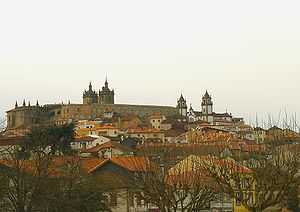Diogo Fernandes (count)
Diogo Fernandes (d. before 1 December 928),[1] (Diego Fernández in Spanish) was a count in the Kingdom of León whose filiation has not been documented although, from his patronymic, it is known that his father was named Fernando,[2] and that he was possibly from Castile.[3] He is the ancestor of many of the important 10th and 11th-century noble families in the County of Portugal and in the Kingdom of León.[4] Although the relationship has not been documented, some authors believe that Diego could have been the brother of Count Ero[5][6] and of Godesteu Fernández who married his niece, Gugina Ériz, daughter of his supposed brother, Ero.[7][8]
Biographical sketch

Diogo arrived at the county of Portugal near the end of the 9th-century, accompanying, according to Sampiro, Infante Bermudo Ordóñez, the son of Ordoño I of Asturias, who after rebelling against his brother King Alfonso III, fled to Coimbra where he lived and died shortly before 928.[9] Count Diego appears for the first time in medieval charters on 28 April 909, confirming a donation made by King Alfonso III.[9] He was also a member of the curia regis of King Ordoño II of León and of his successor Fruela II.[10] He accompanied King Ramiro II when he established his court in Viseu and his last appearance was on 23 February 926 when he confirmed a donation made by this monarch to Hermenegildo González and his wife Mumadona, Diogo's daughter.[11]
Marriage and issue
He married Onecca, who due to confusion with a descendant is often mistakenly called Onega Lucides and made to be daughter of Lucídio Vimaranes, son of Vímara Peres. Onecca could have been a member of the royal house of Pamplona because of the Navarrese, rather than Galician, origin of her name and that of her son Jimeno and some of her descendants.[12] She could have been the daughter of Leodegundia, supposed daughter of King Ordoño I of Asturias, who would have married a prince of Pamplona, based on a document where King Ramiro II of León calls Mumadona Dias his aunt.[3] Onecca appears in December 928 making a donation to the Monastery of Lorvão with her four children, Munia, Ledegundia, Ximeno, and Mummadomna, who confirm the donation, also confirmed by Hermenegildo González, the husband of Mumadona, and Rodrigo Tedoniz, probable husband of Leodegundia Díaz. Onecca made the donation for the soul of Veremudo dive memorie who has been confused with King Bermudo II of León but refers to Bermudo Ordoñez, son of Ordoño I who lived in the County of Portugal and would have been the brother of Leodegundia, who could have been Onecca's mother.[13]
The children of this marriage were:
- Munia Díaz,[14] the wife of Alvito Lucides, and parents of Lucídio Alvites, married to Jimena, who had a daughter named Onecca (Onega) Lucides who is often confused with Munia's mother, Onecca, the wife of Diogo Fernandes.[15]
- Leodegundia Díaz,[14] probably the wife of Rodrigo Tedoniz, who also confirms the donation made in 928.[4]
- Jimeno Díaz (d. between November and December 961),[14] Count and an important figure in the 10th-century, before February 949, he married Adosinda Gutiérrez, daughter of Gutierre Menéndez and Ilduara Ériz, with issue. After Jimeno's death, Adosinda married Ramiro Menéndez, son of count Hermenegildo González,[12] who were probably the parents of Queen Velasquita Ramírez.[16]
- Mumadona Dias, who appears for the first time in February 926 as the wife of Count Hermenegildo González.[17][18][4]
References
- ↑ Sáez 1947, p. 62.
- ↑ Torres Sevilla-Quiñones de León 1999, p. 282.
- ↑ 3.0 3.1 Cardozo 1963, p. 383.
- ↑ 4.0 4.1 4.2 Mattoso 1970, p. 36.
- ↑ Salazar y Acha 1989, p. 69.
- ↑ Sáez 1947, p. 49.
- ↑ Mattoso 1970a, p. 37.
- ↑ Sáez 1947, p. 66–68.
- ↑ 9.0 9.1 Sáez 1947, p. 58.
- ↑ Sáez 1947, p. 60–61.
- ↑ Sáez 1947, p. 61.
- ↑ 12.0 12.1 Torres Sevilla-Quiñones de León 1999, p. 310.
- ↑ Sáez 1947, pp. 105–107.
- ↑ 14.0 14.1 14.2 Cardozo 1963, p. 384.
- ↑ Mattoso 1970b, p. 14.
- ↑ García Álvarez 1960, p. 212.
- ↑ García Álvarez 1960, p. 218.
- ↑ Torres Sevilla-Quiñones de León 1999, p. 295.
Bibliography
- Cardozo, Mario (1963). "Sería Mumadona tia de Ramiro II, Rei de Leão?" (PDF). Bracara Augusta: Revista Cultural (in Portuguese) (Separata, XIV–XV, n.1–2) (Câmara Municipal de Braga). pp. 376–391. OCLC 3256994.
- García Álvarez, Manuel Rubén (1960). "¿La Reina Velasquita, nieta de Muniadomna Díaz?" (PDF). Revista de Guimarães (in Spanish) (70). pp. 197–230.
- Mattoso, José (1970a). "A nobreza portucalense dos séculos IX a XI". Do tempo e da história (in Portuguese) (III) (Lisbon: Instituto de alta cultura. Centro de estudos históricos). pp. 35–50.
- Mattoso, José (1970b). As famílias condais portucalenses dos séculos X e XI. Oporto: Instituto de Alta Cultura: Centro de Estudos Humanísticos, Faculdade de Letras da Universidade do Porto. OCLC 427415056.
- Sáez, Emilio (1947). "Los ascendientes de San Rosendo: notas para el estudio de la monarquía astur-leonesa durante los siglos IX y X". Hispania: revista española de Historia (in Spanish) (XXX) (Madrid: CSIC, Instituto Jerónimo Zurita). pp. 139–156. OCLC 682814356.
- Salazar y Acha, Jaime de (1989). "Los descendientes del conde Ero Fernández, fundador de Monasterio de Santa María de Ferreira de Pallares". El Museo de Pontevedra (in Spanish) (43). pp. 67–86. ISSN 0210-7791.
- Torres Sevilla-Quiñones de León, Margarita Cecilia (1999). Linajes nobiliarios de León y Castilla: Siglos IX-XIII (in Spanish). Salamanca: Junta de Castilla y León, Consejería de educación y cultura. ISBN 84-7846-781-5.